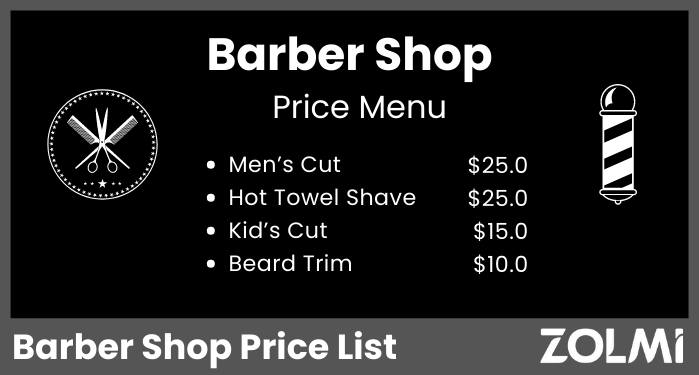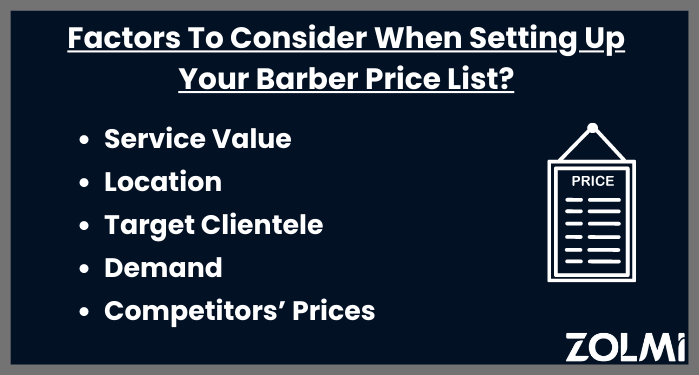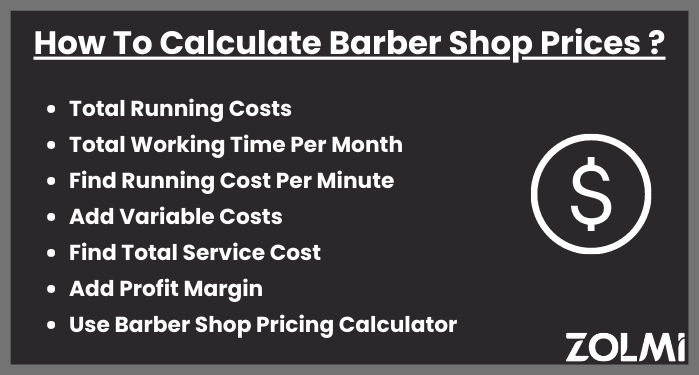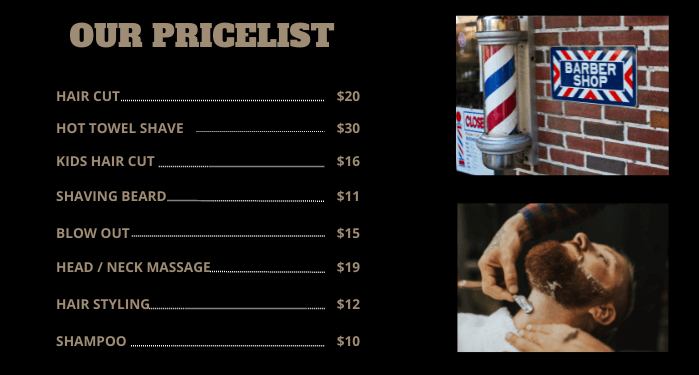Barber Shop Price List


Setting up your barber price list and pricing strategy is a key first step when opening a new barber shop ready to welcome clients. Here are some things you’ll want to think about.
This article covers the strategies you’ll use to create a barber price list that works for your business model, as well as some tips and things to avoid, plus a free template we’ve created.
When you’re figuring out how to set your shop’s prices, there are a few things to keep in mind.
First of all, your barbershop location and target market are key. Both of these will have a big impact on the services you provide and the prices you set.
In addition, your competitor’s prices, what they offer, and any styles or treatments that are trending will also make a difference in your final decisions. Let’s check this out in more detail:
Offering tons of discounts might sound tempting to get clients to try out your barber shop when you first open up, but it’s ultimately not sustainable and can even make it harder to hang on to those clients when you eventually need to raise the prices later.
If you want to stay in business, you’ll need to charge more than your Break Even Point (BEP) for every haircut.
Start by calculating the average price of each service, including supplies, barber’s pay (in terms of time spent), and make sure each price covers these things. After this, anything else you charge will be your profits.
Now, consider your location. This will influence both your service menu and your pricing strategy, since location has an impact on your clientele, how your shop’s brand is perceived, and the kind of competition you’ll be up against.
An upscale urban barber shop can charge a bit more for a men’s haircut or hot shave than a cozy neighborhood one in a small town, for example.
Finally, do your homework and search for your competitors’ websites and social media pages. They’ll usually post price menus online.
What is the average customer in your area like? Are there any schools, office buildings or shopping centers nearby? What about the average income? Look it up online and you’ll have some more insight into what you can offer clients, how much you can charge and even what retail products you might want to sell.
Are beards trendy right now? How about fades or custom designs? Take a look on social media to see what your clients might want- if you’re the only barber in your area offering these services, you can probably charge a bit more for them, especially if they’re in-demand.
While we’re on the topic of competitors, you’ll want to look into what men’s haircut or grooming services they offer, along with the average price of each one. They may be targeting a totally different demographic of clients, or you might have to compete for the same guys.
Make sure to do your homework and look up each other barber shop in your area online before making any decisions about your own menu and prices- you’ll be happy that you did.
While you’ll most likely need to set your prices low enough to compete (unless you’re a well-known or luxury barber shop), you don’t want to undercharge and set haircut costs too low. This can make your brand seem cheap or your barbers seem inexperienced.
Do not miss our post on How to Write a Barber Shop Business Plan.

Your barber shop’s price strategy, along with any promotions or loyalty programs, will depend a lot on how you plan to market your business and what your long-term goals are.
Think of this strategy more like a flexible guide rather than a hard and fast set of rules. You can change tactics later on if you need to create demand for a service or want to market your brand differently.
Here are some of the most commonly-used price strategies, along with some tips to help you implement them.
If you’re a new barber in your local area, this might help you to bring in new customers quickly. You set the average price of a men’s haircut or shave lower at first, then raise these prices gradually as time passes.
There are some potential drawbacks to using this tactic, though. For one, clients might get used to paying lower prices and balk at an increase. Also, you want to be very careful that you don’t undercharge to the point that you won’t earn a profit, and you don’t want to be seen as cheap or low-quality.
For this strategy to work, you have to understand your clients well. You’ll need to get to know them and figure out what services and experiences they value, and then set your prices based on this.
This usually works best for barber shops that are established in the area and have regular clients.
Start by offering your deluxe, fancier services at a higher price, then gradually decrease this as they’re no longer “hot” and in-demand.
To do this, you’ll need to search on social media and follow the latest trends in the barber industry. Of course, you’ll still offer all of your regular services at your standard prices, if someone comes in just looking to get a haircut.
Are you established as a brand? Do you have highly-trained barbers with years of industry experience? If you answered yes, then you might want to use premium pricing for your shop.
This strategy is sometimes called “image pricing” and it relies on the fact that clients are often happy to pay more for a service that they think is prestigious or more valuable.
At the opposite end of the spectrum is economy pricing, which is exactly what it sounds like. You capitalize on making your services more affordable, setting prices lower than the average price of your competition. The key is to be slightly more affordable while not undercharging.
Search online and make sure you can target value-conscious clientele in your area, such as students, seniors or anyone on a limited income.
The pricing structure you choose works together with your strategy to create your price menu as a whole.
Here are the most commonly used pricing structures, as well as how they might work for you:
A straightforward approach that involves charging a single price for a men’s haircut or shave, not including any adjustments for the time it takes or the products used. It’s easy to calculate prices, but not the most flexible method.
Begin with a basic price for haircuts, then let clients select add-ons or upgrades to increase the cost. This is transparent (which customers like) and incentivizes people to indulge and spend more.
Regular haircuts or shaves can be upgraded to include a scalp massage, custom fades or other services.
This can work best for complex, multi-step treatments like custom coloring jobs when it’s hard to price things using your standard menu. Tell clients to “call or email for more information” to handle these requests.
You’ll still need to create your regular price list for everyday haircuts.
This is more commonly used than just variable pricing, since you can offer clients regular services from your barber shop’s menu, but offer to work with them on special requests. If your shop does something unique, this might be a good option.
Basically, this is when you discount a regular hair service, then upsell to make your money. An example of this is cutting hair for a low price, but selling multiple add-ons for hair and beard care at each visit.
If you use this method, you’ll want to train your team to sell additional services and products at each booking.
Do not miss our post on Complete Guide to Barber Shop Expenses.
People sometimes ask me “How much should I charge for a haircut?” In order to answer this, we first have to find out how much a haircut (or anything else on your menu) costs you.
Take a look at each item, then divide it by the time it takes to do it (a $35 haircut that takes an hour is $35 divided by 60 minutes = $0.58 a minute). Now, let’s take this number and move to the next step in the process.
This may sound like a lot, but the calculations are actually fairly straightforward. Remember: the prices you charge will need to cover the cost of running your shop, paying your staff and replacing any products that you use.
Your total expenses for a year. This includes things like rent, taxes, marketing, supplies, utilities, business insurance, cleaning, etc.
Barber Shop Running Costs = (Rent + Taxes + Marketing + Supplies + Utilities + Insurance + Cleaning)/ 12 months
Here’s an example:
If a barber shop pays $45,000 in rent each year, $5,000 in taxes, has marketing costs of $3,000, spends $10,000 on supplies, $8,000 for utilities, $1,000 for insurance and spends $3,000 on cleaning, then it has a running cost of $6,250 every month.
How will this impact the price you’ll charge for the average haircut? Let’s look closer:
Next, you’ll need to calculate how many hours each month your shop is open, then multiply that by the number of chairs or stations you have.
For example, if your barber shop is open 12 hours a day, Monday through Saturday, with ten chairs available, then your Total Monthly Working Time is (12 hours x 24 days a month) x 10 stations = 2,880.
To get this number, take your shop’s running costs per year and divide it by 12 months. Divide that number by your total working hours each month, then divide again by 60 minutes. This gives you your Running Cost Per Minute.
Here’s the formula:
Running Cost Per Minute = Running Cost Per Year / 12 / Total Working Time Per Month / 60
And an example:
Running Cost Per Year ($75,000)/ 12 months / Total Monthly Working Time (2,880 hours)/ 60 = $0.04.
This is how much it costs you every minute to simply keep your doors open.
This is each product you use during a service, plus every staff member’s salary.
Take every barber’s salary, then divide it by their working hours each month. Divide this number by 60 minutes. That’s this person’s cost per minute.
For example, a barber that makes $3000 a month and works 40 hours each week costs:
Team Member’s Salary ($3,000) / their Working Hours Per Month (160) / 60 = Staff Cost per Minute of $0.31.
To get this, take your shop’s running cost per minute and your staff cost per minute, multiplying it by the time that a service takes. Finally, add the cost of supplies.
Here’s the formula:
Service Cost = (Running Cost per Minute + Staff Cost per Minute) x Service Time + Products Used
Let’s use the numbers from our previous examples, assuming that supplies cost us $8 for a basic men’s cut and shave that took an hour to complete.
Service Cost = (Running Cost Per Minute ($0.04) + Staff Cost Per Minute ($0.31)) x Service Time (60 mins) + Products Used ($8) = ($29.00).
Now, it’s time to think about your profits. Remember not to undercharge, since you’ll want to be able to stay in business for many years to come.
Add your profit margin to the service cost to get your final price. Profit margins vary widely within the hair industry (anywhere from 2% to 17%), depending on a number of factors including brand, services and location.
This is what the formula looks like:
Service Price = Service Cost x (1 + Margin).
Along with making it easier to run your barber shop in general, the right barber shop software will make pricing your services much easier.
This software comes with a calculator to help break down each cost, plus tools with helpful insights into how your business is doing, which services are popular and which ones are moving more slowly. This makes it easy for you to adjust or change prices as needed.

While it’s true that most manufacturers set the prices of their products, they’ll often give barbers a range they can charge for them. Take a look on their websites for more information and recommendations for retailers.
Be sure to take the cost of delivery and storage into account when setting each price. Normally, a barber shop’s retail margins will fall somewhere between 50% to 100%. Here are some tips and strategies:
Manufacturer Suggested Retail Price (MSRP)
This is the standard price the manufacturer recommends charging. Barber shops will usually buy retail products at around 50% of this price, making it easy to make a profit. The exact amount will vary a bit between products.
This involves selling multiple items together at a discount. You make money on volume, while also getting rid of less popular products and freeing up shelf space for new ones. A great example is a shampoo and conditioner, paired with a shaving soap or beard oil.
While customers do like getting a deal this way (especially if it’s a gift set during the holiday season), remember that it can be harder to sell these items individually at their regular price later on if you do this for too long.
Grocery stores often use this strategy. Offer customers a popular product at a low price to bring them in, then get them to buy additional things while they’re shopping.
Check out what your competitors are charging, then set your own prices a little lower to attract customers. This can be a great way to bring in clients, but you might have difficulty raising your prices later on.
This strategy is one that works well if your barber shop is already well-known, if you’re in an upscale area, or if you have a staff of highly-trained, prestigious barbers. These shops will charge more for retail items because clients perceive them as superior products.
Offering clients a choice is good, but offering them too many options and different variables can make things confusing for both customers and staff. Keep everything straightforward and use simple language that’s easy to understand.
Only discount things when it makes sense to, such as when products are nearing their best before date, or on seasonal items.
Resist the urge to drop your prices as soon as business is a bit slow. Remember that every industry experiences slower and busier weeks, and lowering prices may just make it harder to increase them again when things pick up.
Using partial numbers like $19 instead of $20 really does work to make prices look smaller. Try not to use decimal places for the same reason. This may seem like a small detail, but it can make a big difference in how people perceive your prices.
Has your team received any special training that makes them particularly qualified to perform certain haircuts or other services? If so, make sure to include this in your expenses when you’re deciding what to charge for these items.
It’s best to be transparent about the reasons for any price changes. Trust your clients and work towards building strong relationships with them.
As you begin creating your custom barber shop price list, factoring in the cost and time of each item, deciding what to include in your menu is essential.
Most barber shop owners start with the basics, listing out haircuts, styling, coloring services and shaves. After this, you may want to add some specialty items to appeal to your target market. Finally, take a look at add-ons or additional options you want to offer clients.
Make sure to post everything on your shop’s website and social media pages.
To help provide some inspiration and make things easier, we’ve created this barber shop price list template, free for you to use. Go ahead and make any changes as needed.

Getting your barber shop price list design ready, planning out the services you’ll offer and calculating the cost of each item on the menu may sound intimidating at first, but the right amount of planning can make everything much easier.
In fact, creating your barber price list is a great way to get to know every aspect of your business, including your future clients and the competitors in your area. This will make it easier to make other business decisions down the road.
Is it time to rethink your pricing strategy
http://gsl-archive.mit.edu/media/programs/mexico-summer-2015/materials/is_it_time_to_rethink_your_pricing_strategy.pdf
10 Asset Pricing Implications of Equilibrium Business Cycle Models
https://www.degruyter.com/document/doi/10.1515/9780691218052-014/html
A strategic approach to industrial product pricing: The pricing plan
https://www.sciencedirect.com/science/article/pii/S0019850104001208